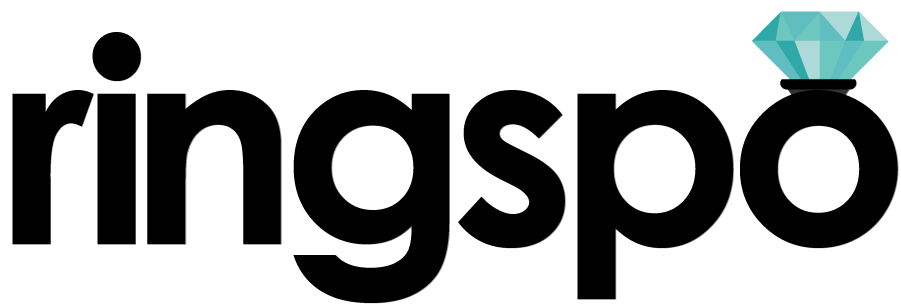How To Sell Gold
Navigating the Golden Opportunity: How To Make The Most Money When Selling Gold
Considering selling your gold jewelry or other gold items but want to make sure you don’t get ripped off?
This guide will walk you through the process of how to sell gold with an eye firmly on ensuring you get the most money possible.
Whether you’re selling gold jewelry, bullion, or scrap gold, there are some key principles to understand and some important ‘watch-outs’ to avoid.
Let’s get to it.

Four Steps to Selling Your Gold for the Most Money Possible
First, we’ll outline the steps, then we’ll look at each in more detail
Step 1: Determine Its Value
Before you start actively selling your gold , you need to work how much it’s worth so you know whether the prices you’re being offered are fair, or if the potential buyer is trying to take advantage of you.
Step 2: Find a Reputable Buyer
The next step involves finding a trustworthy buyer who offers competitive prices.
There are many options here – a local jewelry store, a pawn shop, or an online gold buying company. Each have their own advantages and disadvantages. However, one is likely to give you significantly more than the others, while one type of buyer in particular is known for low-ball offers.
Step 3: Compare & Negotiate a Fair Price
Once you have a shortlist of potential buyers, it’s time to compare and negotiate. Don’t be afraid to haggle. Some buyers expect it and initially offer a lower price knowing there will be some negotiation.
Step 4: Complete the Transaction
After you’ve agreed on a price, the final step is to complete the transaction. Key here is to make you are happy with the payment terms, get a receipt detailing the weight and purity of the gold you sold, the price you agreed on, and the name and address of the buyer. This is not only for your records but also in case any disputes arise later.
1. How to Find Out How Much Your Gold Is Worth
Calculating the value of your gold is pretty straight-forward, but there is a bit of a process involved.
Firstly, here are the key factors that contribute to your gold’s value:
- Purity: Pure gold is 24 karat, but most gold items are alloyed with other metals, reducing its purity.
- Weight: The heavier your gold item, the more it’s worth.
- Market price: The current market price of gold changes every day
- Buyer’s offer: Different buyers may offer varying prices, so being smart here can make the biggest difference to how much you receive

We have a whole post dedicated to helping you understand how much you’ll get when you sell your gold, but we’ll give you the cliffnotes below.
To estimate your gold’s value, you need to find out its purity, weight, and the current market price for gold.
How to Check the Purity and Weight of Your Gold
Most people have heard of gold karats, but not everyone really knows what this means.
Karat is a measure of the purity of gold and is measured on a scale using 24 karats.
24 karat gold is 100% pure gold, while 12 karat is 50% pure gold.
Each of the different karats basically indicates how much gold is contained and the further down you go on the “karat” scale the less pure your gold is
| Karat | Parts gold | Purity |
|---|---|---|
| 24 karat gold | 24/24 | 100% pure gold |
| 22 karat gold | 22/24 | 91.6% pure gold |
| 18 karat gold | 18/24 | 75% pure gold |
| 14 karat gold | 14/24 | 58.5% pure gold |
| 12 karat gold | 12/24 | 50% pure gold |
| 10 karat gold | 10/24 | 41.7% pure gold |
| 9 karat gold | 9/24 | 37.5% pure gold |
This may sound obvious, but the amount of raw gold in your item will affect the price that you will be able to sell it for.
18 is a 50% larger number than 12, so an 18 karat wedding ring has 50% more gold in it than a 12 karat gold ring. An 18 karat wedding ring will therefore be worth 50% more to the gold buyer as it is the raw gold it contains that they are concerned about.
How to find out what type of gold you have
Most gold items will have the type of gold they are stamped on them. If this is a ring, it’s likely to be stamped on the inside of the band.
While some gold items will use the karat system and have, for example, ‘18k’ stamped on them, some items may use the European Hallmark system which uses a number to relate to the percentage purity:
| Hallmark | Purity | Karat |
|---|---|---|
| 999 | 100% pure gold | 24 karat gold |
| 916 | 91.6% pure gold | 22 karat gold |
| 750 | 75% pure gold | 18 karat gold |
| 585 | 58.5% pure gold | 14 karat gold |
| 500 | 50% pure gold | 12 karat gold |
| 417 | 41.7% pure gold | 10 karat gold |
| 375 | 37.5% pure gold | 9 karat gold |
‘750’ hallmark, indicating 18 karat gold:
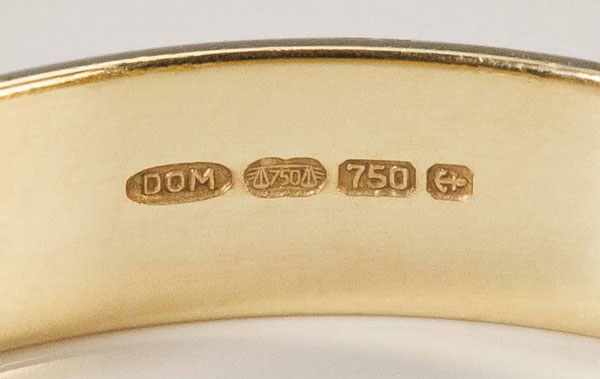
22k hallmark:
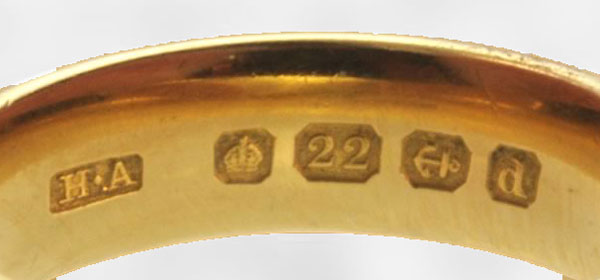
Selling yellow gold vs. rose gold vs. white gold
Much modern jewelry is white gold, and in the last 10 years ‘rose gold’ has also become increasingly popular:

White gold and rose gold both also use the karat system to show how much pure gold they contain.
The difference between each of the three colors of gold is the other metals used to make up the rest of the alloy. The different blends of metals give each type of golds its distinctive color.
Typical compositions of 14 karat yellow gold, white gold and rose gold are:
14 karat yellow gold composition:
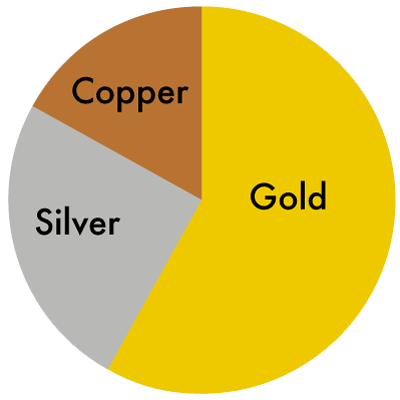
- 58.5% gold
- 25% silver
- 17% copper
14 karat white gold composition:
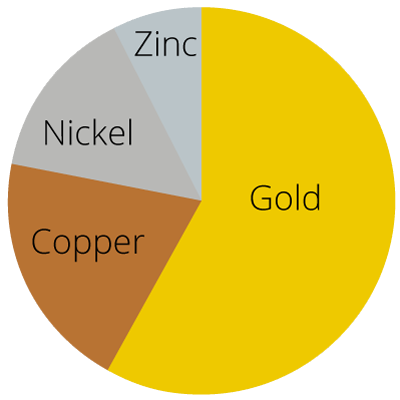
- 58.5% gold
- 20% copper
- 14.5% nickel
- 7.5% zinc
14 karat rose gold composition:
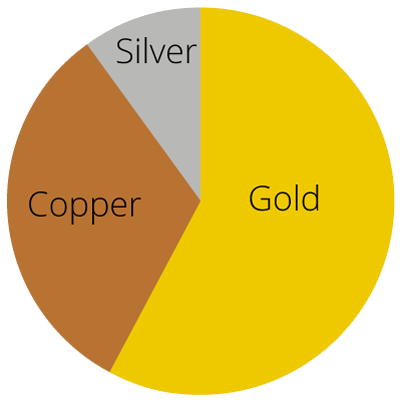
- 58.5% gold
- 30% copper
- 21.5% silver
The important thing to look at is that each of the three types of gold have the exact same amount of pure gold in them – 58.5%.
Understanding the purity as a percentage is key as we’ll use this when calculating how much gold your item contains.
Next up, it’s important to understand how gold weight is measured.
Gold’s weight is typically measured in grams (g) or troy ounces (ozt), with 1 g equaling 0.032 ozt, and 1 ozt equaling 31.1 g.
In the US, you’ll usually see gold prices given in a price per troy ounce.
How to Measure Gold Purity and Weight
To determine your gold’s purity and weight, follow these steps:
1. Separate out the items
If you have multiple items to sell, separate them out and treat them as individual items.
While items that are made of the same type of gold can be grouped together later, for the moment you need to look at them individually.
2. Check each item for markings:
With a magnifying glass or a jeweler’s loupe, examine your gold item for any markings. These usually indicate the karat and sometimes the weight.
Here’s a quick guide to common gold markings:
- 14K: 14 karat gold
- 585: 58.5% pure gold (equivalent to 14K)
- P: Plumb gold (guaranteed to be at least the stated karat)
- GP: Gold plated (not solid gold)
- HGE: Heavy gold electroplate (not solid gold)
- GE: Gold electroplate (not solid gold)
- GF: Gold filled (not solid gold)
- RGP: Rolled gold plate (not solid gold)
- DWT: Pennyweight (a unit of weight equal to 1.555 g or 0.05 ozt)
3. Weigh the items
If the weight isn’t stamped on your item, you’ll need to weigh it. You can do this using a kitchen scale.
If you don’t have one that’s suitable, you can pick one up from Amazon for around $10.
If your item has any detachable elements or stones, remove them first to ensure that you’re just weighing the gold.
If you have several items of the same gold purity, you can weigh these together. However, different gold purities must be weight separately. Keep a note of the weight of the gold items and their purity.
4. Calculate the amount of actual gold in each item
Once you know the weight of each items and it
Once you have this information, you can use an online gold calculator to get an estimate of the ‘melt value’, which depends on the market price of gold on the day that you’re looking.
How to Check the Market Price of Gold
The market price of gold constantly changes, and is affected by a huge number of factors: supply and demand, geopolitical events, currency exchange rates, and more.
The most reliable way to understand the current spot price is to check online e.g. on the Alloy Market website where they keep it constantly updated.
How to Calculate the Melt Value of Your Gold
The ‘melt value’ or ‘scrap value’ of your gold represents how much your gold is worth if it were melted down and sold purely based on its gold content.
It’s calculated using the gold’s purity, weight, and the current market price of gold.
Here’s a simple formula to calculate the melt value:
Melt Value = (Purity / 24) x (Weight in ozt) x (Market Price in USD/ozt)
That might not look simple, but it’s basically working out how much your gold is worth in terms of its raw gold content.
Let’s look at an example:
Suppose you have a 14K gold ring that weighs 10 grams. If the current market price of gold is $1,800 USD/ozt, here’s how you calculate the melt value:
Melt Value = (14 / 24) x (10 / 31.1) x $1,800
Melt Value = $257.53 USD
In this case, the melt value of your 14K gold ring is approximately $257.53 USD.
Remember, the melt value is a baseline and doesn’t account for design, brand, age, or other subjective factors that may enhance your item’s value.
It also isn’t reflective of how much you will actually receive for your gold.
Anyone buying your gold can only offer you a % of melt value, to ensure that they can run their business profitably. How much of a % of the melt value you are offered can differ from 20% – 75%, as we’ll see later.
How to Check the Condition and Appeal of Your Gold

Once you’ve worked out the melt value, it’s important to consider other factors that could affect how much you will get for your gold.
This is important because some gold items can be worth much more than just their melt value if they hold historical value or if they are produced by a brand that is valued.
Assessing the Condition of Your Gold
Damaged gold that is going to be melted down isn’t usually worth less than gold in perfect condition, but a gold item that is going to be sold as the item itself e.g. a gold coin definitely is.
Start by inspecting your gold for any visible damage, such as scratches, dents, bends, breaks, or missing parts.
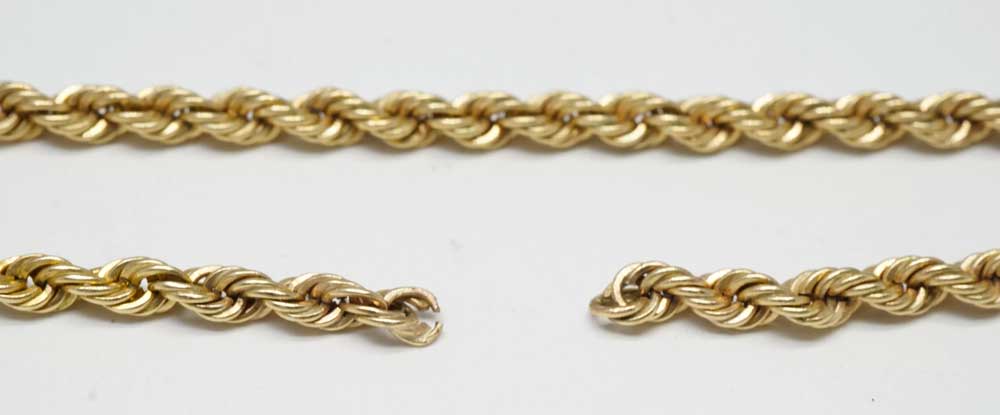
To inspect your gold, use a magnifying glass or a jeweler’s loupe, and hold your item under a bright light to see the finer details. Comparing it with similar items online or in person can also give you a sense of the condition of your piece.
Cleaning Your Gold
When you’re offering anything for sale, it’s always a good idea to present it in the best possible light.
Clean your gold using a soft cloth and mild soap and water to remove any dirt or tarnish from the surface. Avoid harsh chemicals or abrasives that could damage the gold, dry it thoroughly after washing and store it in a clean, dry place.
Gold ring before polishing:
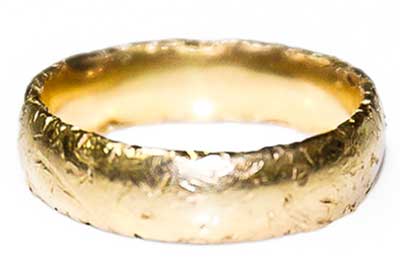
Gold ring after polishing:
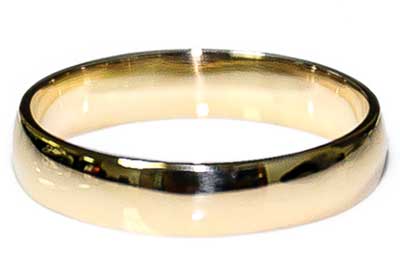
While it may not make a difference to the offer you receive, a clean gold piece usually looks more appealing than dirty or tarnished gold, and could mean that you attract higher offers.
Evaluating the Appeal of Your Gold
Evaluating the appeal of your gold involves examining its design, style, craftsmanship, brand, and uniqueness. This task can be subjective, so researching online or consulting an appraiser or an expert could be beneficial.
Some gold items may have a higher value than their melt value due to their unique appeal. Examples include estate jewelry, antique jewelry, rare coins, designer pieces, or collectibles.
For instance, a Cartier Love bracelet, which may have a melt value of $1,500, but as a piece of branded jewelry, it could be sold for up to $6,000.
Similarly, a 1907 Saint-Gaudens Double Eagle coin might be worth $20 as bullion, but as a collector’s item, it could be valued at $2 million.
If you have an item that could possibly have some appeal as an object, rather than just as gold melt, it’s always better to research around it first and then consult a specialist.
If you’ve inherited gold jewelry, it’s essential to be aware of potential tax implications. Learn more about the tax on inherited jewelry to ensure you’re fully informed before selling.
How to Choose the Best Buyer for Your Gold
There are several types of places you could sell your gold, each with its own set of advantages and drawbacks.
When choosing where to sell your gold, consider the reputation, reviews, fees, payment methods, speed, and convenience of each buyer.
- Online buyers offer convenience as the process can be done from your home. However, you’ll need to ship your gold, which can involve extra fees and security concerns.
- Local buyers, such as jewelers or pawn shops, allow you to sell your gold in person, which can be reassuring, but their offers might be lower due to overhead costs.
- Metal recyclers could be an option for scrap gold, although they may not offer as much as a dedicated gold buyer would.
Avoid scams and lowball offers by checking the credentials of the buyer, reading the fine print of any contract, and getting multiple quotes. Choosing the right buyer for your gold is the biggest factor that determines how much you will receive for it.
How to Negotiate a Fair Price for Your Gold
Negotiating a fair price for your gold is vital for maximizing your profit and ensuring your satisfaction.
Factors Influencing the Buyer’s Offer
Firstly, it’s important to understand that not all initial offers will be equal. The price that buyers offer for your gold can be affected by their own overhead costs, profit margins, market conditions, and demand.
Therefore, it’s essential to have a solid understanding of the value of your gold before starting negotiations.
Comparing Offers and Negotiation Tips
Compare the offers from different buyers based on their price per gram or per troy ounce, their fees or commissions, and their payment methods and terms.
If you followed the process we talked through earlier, you should know the melt price of your gold.
It can also be a good idea to have a minimum acceptable price in mind before you start negotiations.
Sample Gold Selling Negotiation Scenario
Suppose a buyer offers $80 for your 14K gold necklace, but your research indicates that the melt value is around $200. You could say, “Based on my research and the current gold market price, I believe this necklace is worth closer to $200. Can you match that?”
If they counteroffer with $175, and this is above your minimum acceptable price, you can either accept it or try to negotiate further, saying, “Could we meet in the middle at $190?”
Remember, being confident and informed during the negotiation process can help you secure the best price for your gold.
How to Sell Your Gold Safely and Securely
Selling your gold safely and securely is vital to protect both you and your valuable items from potential theft or damage.
When selling your gold, it’s essential to verify the buyer’s credentials. Ensure they are licensed and have a good reputation. Always make sure

After the transaction, obtain a receipt detailing the item’s description, weight, price, and the date of sale.
If you’re shipping your gold to an online buyer, make sure it’s insured. Keeping a record of your transaction, including correspondence, is also a smart move.
Selling Your Gold Safely Online
Selling your gold online safely involves using a reputable buyer that offers free insured shipping. This safeguards your gold during transit. Tracking your package is also important, as it allows you to know where your gold is at all times.
Ideally, you should receive payment within 24 hours of the buyer receiving and appraising your gold.
Selling Your Gold Safely Locally
If you’re selling your gold locally, try to arrange a meeting in a public location. Bringing a friend or a witness with you can enhance your safety. Once you’ve agreed on a price, secure payment either in cash or check for added security.
How to Sell Gold FAQs
What steps should I take to prepare gold for sale?
Before selling your gold, it’s important to organize it by karat, determine its weight, and possibly get an appraisal. Make sure to remove any gemstones if selling jewelry. It’s also wise to research gold prices so you know what to expect.
What’s the difference between selling gold jewelry and selling gold bullion?
Selling gold jewelry often involves considering the craftsmanship and design of the piece, not just the value of the gold. Gold bullion, on the other hand, is valued based purely on its weight and purity.
How can I determine the purity and weight of my gold before selling it?
Gold purity is usually stamped on jewelry and coins in karats or as a decimal fraction. For example, “24K” or “0.999” indicate pure gold. For weight, use a jeweler’s scale. When selling, gold is often weighed in grams or troy ounces.
Should I separate my gold items by karat before selling?
Yes, it’s helpful to separate your gold items by karat as different purities command different prices. Mixed-karat gold may be valued at the lowest karat in the mix.
Is it necessary to get an appraisal before selling my gold?
While not always necessary, an appraisal can give you a benchmark for your gold’s worth. It’s particularly useful for gold jewelry where craftsmanship, historical value, or gemstones may add to the value.
How do I know if gold is real gold?
In an ideal world we would be able to rely on hallmarks to verify whether something is real gold or not. Unfortunately, however, this is not always the case. Acid is commonly used to test gold and you can do this at home using white vinegar:
1: Pour white vinegar into a glass
2: Place your item into the glass of vinegar.
3: Let the item sit in the glass of vinegar for approximately 15 minutes.
4: Remove the item and rinse with water
If it’s real gold, your item will shine brightly. If it’s fake gold then there will be a reaction with the ascetic acid in the vinegar and it will become discolored.
Note: It’s important to know that this test can permanently discolor the item you are testing if it is not real gold.
What does dwt mean when it comes to gold?
DWT is the abbreviation for ‘pennyweight’. The ‘d’ comes from ‘denarius’, an ancient Roman coin, while the ‘wt’ represents ‘weight’.
1dwt = 1.555 grams
